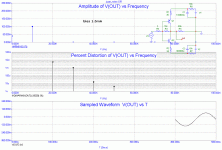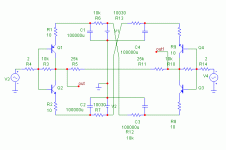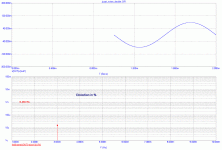janneman said:
What does this circuit do, actually?
Jan Didden
Amplifies, up to some 50dB. My guess is that it was old John's MC preamp input stage.
PMA said:And some are never, ain't that so?
Please stay technical.
Mind your own business.
PMA said:
Amplifies, up to some 50dB. My guess is that it was old John's MC preamp input stage.
That's interesting, with such heavy C-B feedback.
Edit: I see you changed R3 from 100 ohms to 10k. Did that change the gain?
Jan Didden
janneman said:
That's interesting.....
Jan Didden
OT Jan, I enjoyed your interview of Eduardo de Lima in the new "Voice Coil".
Best, Chuck Hansen
PMA said:John -
why not this?
Hereby distortion, same output (100mV). Less than 0.00002%. Gain 57dB. F(-3dB) = 1.7MHz. Wow!
Attachments
AndrewT said:Hi PMA,
R5 & 11 not connected to zero volt line?
No, symmetrical output. But can be connected without change of distortion.
PMA said:Yes, it changes gain, and should be chosen according to bias current.
Of course it changed the gain. And of course this circuit has relatively low distortion. This circuit is nothing but heavy NFB so there's no surprise about. This FB type also decreases both the input and output impedances by the loop gain. This makes this little circuit a transimpedance amp.
And of course it has a low noise - having such a low input impedance.
And of course it needs high Iq - the 100 ohm resistor loads the output, in parallel with the 50k "load" and it's of course the gm*100 ohm that sets the OL gain. And if you want any performance improvement by means of NFB you need some OLG, isn't it?
And of course you can lower the Iq if you increase the feedback resistor to 10k, to get the same OL gain.
It's funny how people moan about feedback but don't miss any opportunity to conveniently use it in their circuits.
There is a feedback and feedback. This has nothing to do with conventional dominant-pole VFB design. 57dB and 1.7MHz BW, no slew rate limitation. This counts.
We care how it sounds, not only how it measures THD in audio band.
We care how it sounds, not only how it measures THD in audio band.
PMA, thanks for your input. I beta match to remove any significant bias. Typically, 2.5 ma and 10 ohm Re is normal. 2 x D battery powered. Re could be slightly offset to remove even harmonics. i.e. 11 ohm, 9 ohm for example. Initial even harmonic probably due to bipolar model differences in diode equation.
This is the essence of the Levinson JC-1 pre-preamp, and the SOTA headamp. Made obsolete by Vendetta in 1982.
This is the essence of the Levinson JC-1 pre-preamp, and the SOTA headamp. Made obsolete by Vendetta in 1982.
PMA, you could eliminate the big caps by just making it truly differential with the complementary connection intact. It makes it simpler, balanced and removes the big caps. Slightly noisier though. Noise is EVERYTHING in this circuit.
For a low Z input, the single sided circuit can be driven into the emitters and the bases shorted to ground. This is the essence of the JC-1 AC, JC-1 DC, and the Ortofon phono stage.
syn08 said:
Of course it changed the gain. And of course this circuit has relatively low distortion. This circuit is nothing but heavy NFB so there's no surprise about. This FB type also decreases both the input and output impedances by the loop gain. This makes this little circuit a transimpedance amp.
And of course it has a low noise - having such a low input impedance.
And of course it needs high Iq - the 100 ohm resistor loads the output, in parallel with the 50k "load" and it's of course the gm*100 ohm that sets the OL gain. And if you want any performance improvement by means of NFB you need some OLG, isn't it?
And of course you can lower the Iq if you increase the feedback resistor to 10k, to get the same OL gain.
It's funny how people moan about feedback but don't miss any opportunity to conveniently use it in their circuits.
Thank you 😉
Jan Didden
This circuit can be OK without any feedback of any consequence. In fact, it will be even quieter. Please remember 100mV is the MAXIMUM output and usually measures about .1% DUH!. Actual operation is more like 10mV out and less. It drives other people's moving magnet phono stages directly, and will overload them if you are not careful.
IT IS A TRANSFORMER ELIMINATOR!
IT IS A TRANSFORMER ELIMINATOR!
- Status
- Not open for further replies.
- Home
- Amplifiers
- Solid State
- John Curl's Blowtorch preamplifier


